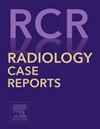Diagnostic misdirection in posterior-onset Rasmussen's encephalitis: A case report
Q4 Medicine
引用次数: 0
Abstract
Rasmussen's encephalitis (RE) is a rare, chronic, and progressive inflammatory brain disorder, characterized by drug-resistant seizures, cognitive decline, and unihemispheric atrophy. Focal neurological deficits and focal motor seizures are typically the initial manifestations. However, we encountered an exceptionally rare case where occipital seizures were the sole presenting feature. This unusual presentation poses unique diagnostic and therapeutic challenges, stemming from its posterior seizure onset and atypical clinical profile, complicating recognition and effective management. We report the case of an 11-year-old boy with no prior medical or familial history of epilepsy. Born to nonconsanguineous parents, his prenatal, perinatal, and early developmental milestones were unremarkable. The patient exhibited normal psychomotor development until 5 years prior to presentation, when occipital drug-resistant visual seizures began. Clinical, imaging, and electrophysiological findings revealed posterior-onset seizures and unilateral hemispheric atrophy consistent with Rasmussen's encephalitis. Posterior-Onset seizures can present as the exclusive initial manifestation of Rasmussen's encephalitis. This case highlights the importance of considering this diagnosis in patients with newly diagnosed drug-resistant visual seizures particularly when accompanied by cognitive decline.
后发性拉斯穆森脑炎的误诊1例
拉斯穆森脑炎(RE)是一种罕见的慢性进行性炎症性脑疾病,以耐药癫痫发作、认知能力下降和单半球萎缩为特征。局灶性神经功能缺损和局灶性运动癫痫是典型的初始表现。然而,我们遇到了一个非常罕见的病例,枕部癫痫发作是唯一的表现特征。这种不寻常的表现提出了独特的诊断和治疗挑战,源于其后发癫痫发作和非典型临床特征,复杂的识别和有效的管理。我们报告的情况下,一个11岁的男孩没有医疗或家族病史的癫痫。他出生在非近亲家庭,他的产前、围产期和早期发育里程碑都不显著。患者表现出正常的精神运动发展,直到发病前5年,枕部耐药视觉发作开始。临床、影像学和电生理结果显示发病后癫痫发作和单侧半球萎缩与拉斯穆森脑炎一致。后发性癫痫可作为拉斯穆森脑炎的唯一初始表现。本病例强调了在新诊断的耐药视觉癫痫患者中考虑这一诊断的重要性,特别是当伴有认知能力下降时。
本文章由计算机程序翻译,如有差异,请以英文原文为准。
求助全文
约1分钟内获得全文
求助全文
来源期刊

Radiology Case Reports
Medicine-Radiology, Nuclear Medicine and Imaging
CiteScore
1.10
自引率
0.00%
发文量
1074
审稿时长
30 days
期刊介绍:
The content of this journal is exclusively case reports that feature diagnostic imaging. Categories in which case reports can be placed include the musculoskeletal system, spine, central nervous system, head and neck, cardiovascular, chest, gastrointestinal, genitourinary, multisystem, pediatric, emergency, women''s imaging, oncologic, normal variants, medical devices, foreign bodies, interventional radiology, nuclear medicine, molecular imaging, ultrasonography, imaging artifacts, forensic, anthropological, and medical-legal. Articles must be well-documented and include a review of the appropriate literature.
 求助内容:
求助内容: 应助结果提醒方式:
应助结果提醒方式:


